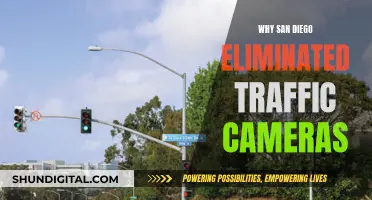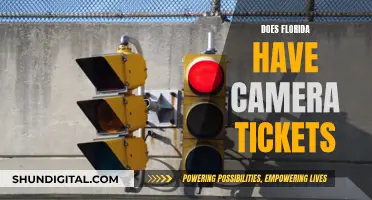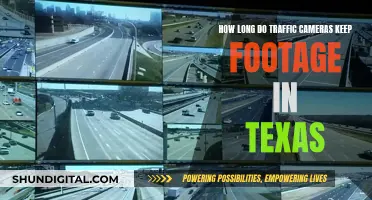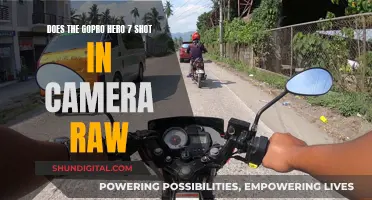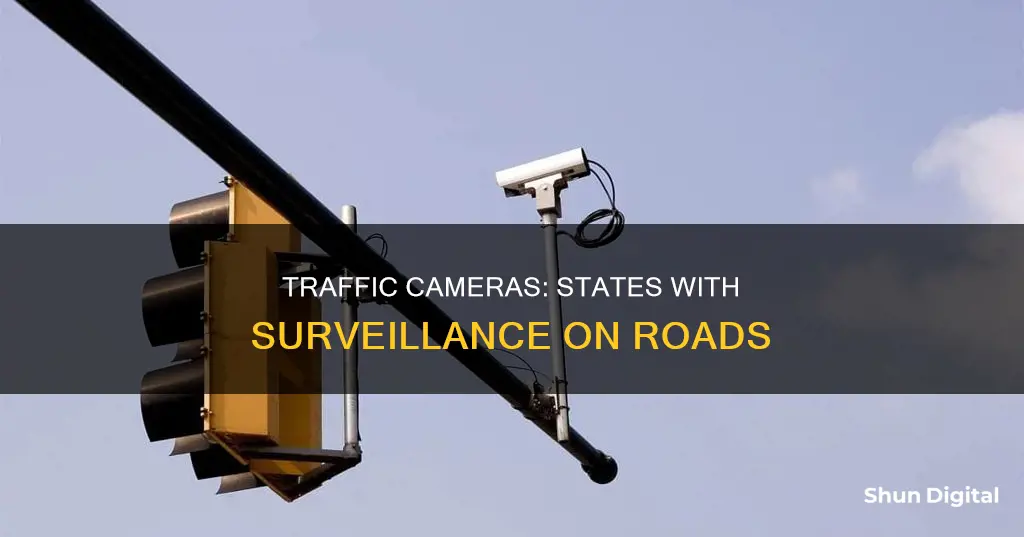
Traffic cameras are an increasingly common feature of roads in the United States, with states taking measures to enforce traffic laws more strictly and reduce the number of accidents. There are two main types of traffic cameras: speed cameras and red-light cameras. Speed cameras detect and deter speeders, while red-light cameras capture vehicles that enter an intersection when the light is red. As of 2024, there are over 5,000 speed cameras in the US, with Washington D.C. having the highest number, followed by New York. In total, 19 states and Washington D.C. have passed laws permitting the use of speed cameras, while 9 states have prohibited them. For red-light cameras, 22 states and Washington D.C. have enacted laws permitting their use, while 8 states have prohibited them.
| Characteristics | Values |
|---|---|
| Number of states with red light cameras | 23 |
| States with red light cameras in specific jurisdictions | Alabama, Hawaii, Illinois, Iowa, Louisiana, Missouri, New Mexico, New York, and North Carolina |
| States with red light cameras allowed statewide | Arizona, California, Colorado, Delaware, Florida, Georgia, Maryland, Ohio, Oregon, Pennsylvania, Rhode Island, Tennessee, Virginia, and Washington |
| States with no law that explicitly makes the use of red light cameras illegal | 12 |
| Number of states with speed cameras | 19 |
| States with the most traffic cameras | Washington D.C. and New York |
What You'll Learn

Which states have red light cameras?
In the United States, red light cameras are used in 23 states, as well as in Washington, D.C.
Alabama, Hawaii, Illinois, Iowa, Louisiana, Missouri, New Mexico, New York, and North Carolina allow the use of red light cameras in specific jurisdictions. Arizona, California, Colorado, Delaware, Florida, Georgia, Maryland, Ohio, Oregon, Pennsylvania, Rhode Island, Tennessee, Virginia, and Washington allow red light cameras to be used statewide.
Twelve states have no laws that explicitly prohibit the use of red light cameras, and it is possible that their use will expand across the entire country in the near future.
However, some states have chosen to prohibit the use of red light cameras. These include Arkansas, Maine, Michigan, Mississippi, Montana, Nebraska, Nevada, New Hampshire, South Carolina, Texas, Utah, and West Virginia.
Springfield, MO: Traffic Tickets from Cameras?
You may want to see also

Which states have speed cameras?
The use of speed cameras varies across the United States, with some states permitting their use, some prohibiting them, and others remaining silent on the issue. As of May 2024, 19 states and Washington, D.C., have passed laws permitting the use of speed cameras, while 9 states have enacted laws banning them.
States that allow speed cameras include:
- Alabama, but only in specific jurisdictions such as Center Point and Midfield.
- Arizona, as long as it complies with state standards.
- Arkansas, but only in school zones, railroad crossings, and highway work zones when a police officer is present.
- California, with some cities starting speed camera programs in 2024.
- Colorado, but only in limited circumstances.
- Connecticut, allowing local governments to use automated traffic enforcement systems.
- Delaware, which has a five-year trial period permitting speeding cameras in specific jurisdictions.
- Florida, which permits traffic law enforcement through traffic infraction detectors such as cameras.
- Georgia, which allows speed detection devices.
- Indiana, which has a pilot program allowing speed cameras in limited road worksites.
- Louisiana, through local ordinances, but signs must be posted where cameras are active.
- Maryland, which frequently changes the locations of its speeding cameras.
- Missouri, but the state Supreme Court has made tickets issued via speed cameras virtually unenforceable.
- New York, but only in school zones.
- Ohio, but a police officer must be present.
- Oregon, if they comply with state statutes.
- Pennsylvania, but only in work zones.
- Rhode Island, but only in school zones.
- Tennessee, which permits traffic cameras.
- Utah, but only in school zones or roads with speed limits of 30 mph or less, when a police officer is present, and when a local ordinance allows them.
- Virginia, but only in school zones and work zones.
- Washington, D.C., which has the highest number of traffic cameras in the country.
On the other hand, the following states have banned speed cameras:
- Mississippi, which prohibits using automated recording equipment to enforce traffic laws.
- Montana, which prohibits using automated enforcement systems to issue tickets.
- Nevada, with limited exceptions, such as cameras installed in law enforcement vehicles.
- New Hampshire, which bans most types of highway surveillance systems.
- New Jersey, following the end of its automated traffic enforcement pilot program.
- South Carolina, except during emergencies.
- South Dakota, which prohibits speed cameras for traffic enforcement.
- Texas, which bans red light and speeding traffic enforcement cameras.
- Wisconsin, which prohibits speed radar cameras.
Some states, such as Iowa, have no statewide law regarding speed cameras, but local areas may operate programs under local ordinances. Additionally, some states do not explicitly address the use of speed cameras, and localities may operate speed cameras even without specific state permission or prohibition.
Computer Cameras: Trustworthy or Deceitful?
You may want to see also

What are the penalties for red light camera violations?
Red light cameras are a type of automated enforcement technology used to detect and deter red-light runners. They are fairly accurate but can sometimes be falsely triggered. When a vehicle passes over a sensor in an intersection while the light is red, the camera is triggered and takes pictures of the vehicle's license plate and the driver. Many camera systems also take video footage of the vehicle driving through the red light.
If you receive a red light camera ticket, you can fight it. The first step is to view the photos and videos. The ticket will usually include the photos, and a web address to view the video footage. You can also read the state law pertaining to red light cameras to understand the available defences. For example, in most states, it's the driver, not the owner, who is liable for the violation. Many states allow owners who receive tickets to submit an affidavit swearing that they were not driving when the violation occurred, which will usually result in the dismissal of the ticket.
The penalties for red light camera violations vary depending on the jurisdiction. In some states, red light camera tickets carry the same penalties as any other red light violation, which generally includes fines ranging from $75 to $400 and demerit points being assessed against the driver's record. However, in most states, red light camera violations are penalised less severely than traditional stoplight tickets issued by an officer. Camera violation fines are usually much lower, ranging from a minimum of $60 to a maximum of $500, and camera tickets typically do not result in demerit points or appear on criminal or driving records.
Viewing Zmodo Cameras on Computers: A Step-by-Step Guide
You may want to see also

How do red light cameras work?
Red light cameras are automated enforcement systems that law enforcement uses to monitor intersections and catch drivers who violate traffic light laws. They are synchronised with traffic signals and work in conjunction with sensors installed in the road. When a vehicle drives into an intersection and passes the stop line, the sensors are triggered, activating the camera.
The cameras are typically positioned at the corners of an intersection, mounted on poles a few yards high, pointing inward to capture vehicles from different angles as they pass through. Some systems use film cameras, but most newer systems use digital cameras.
If a red light camera catches your car failing to stop, you will typically receive a ticket in the mail, along with photographs of your vehicle's violation and your license plate, and instructions for paying the associated fine or appearing in court. The fines vary depending on the jurisdiction, and in some cases, the vehicle owner may be presumed responsible for the violation. However, it is possible to contest a red light camera ticket by providing evidence that may exonerate you, such as proving that there was no warning sign of the camera's presence.
The use of red light cameras is a controversial topic, with some people considering them a reasonable safety measure, while others view them as an invasion of privacy. Proponents of red light cameras argue that they improve safety by deterring drivers from running red lights and reducing the number of fatal crashes. On the other hand, critics argue that they may infringe on civil liberties and contribute to errors or misuse by law enforcement.
As of June 2023, nearly 350 communities in the United States use red light cameras, while eight states have banned them.
Fight Ohio Camera Speeding Tickets: What You Need to Know
You may want to see also

What are the most innovative uses of traffic cameras?
Traffic cameras are an increasingly common feature of roads across the United States, with 23 states currently employing red light cameras, and 19 states and the District of Columbia permitting the use of speed cameras. While the primary purpose of these cameras is to enforce road safety laws, there are several innovative uses of traffic cameras that go beyond simple traffic enforcement.
One of the most innovative uses of traffic cameras is in the field of accident prevention. In Bellevue, Washington, the city government has implemented a program that uses machine learning and AI to analyze footage from 360-degree traffic cameras to identify potential crash hotspots and dangerous traffic patterns. This allows the city to take proactive measures to improve road safety and work towards "Vision Zero" – a strategy that aims to eliminate deaths and serious injuries from traffic collisions. The program has been praised by Washington's Secretary of Transportation, who highlighted the potential of analytics and AI to predict and eliminate crashes.
Another innovative use of traffic cameras is in the detection of other road violations, such as illegal use of bus lanes, toll violations, or noise pollution. For example, in New York City, bus lane enforcement cameras were used to fine taxi drivers who were illegally using the bus lanes. Similarly, noise enforcement cameras have been trialed in cities worldwide, including Taipei and Edmonton, to monitor and enforce compliance with local or national vehicle noise limits. These cameras are triggered by a microphone that detects vehicles emitting sound above a pre-set decibel limit, allowing the police or local government to take appropriate action.
In addition to road safety, traffic cameras can also be used for security and surveillance purposes. For instance, in Los Angeles, Mobile Surveillance Units (MSUs) were used by the LAPD to help bust a major railroad crime ring. This example demonstrates the versatility of traffic cameras as a tool for law enforcement and public safety.
While the use of traffic cameras has sparked some controversy and privacy concerns, their effectiveness in reducing accidents and improving road safety is well-documented. As technology advances, it is likely that we will see even more innovative uses of traffic cameras in the future, further enhancing their role in keeping our roads and communities safe.
Do Arizona Police Cars Have Cameras?
You may want to see also
Frequently asked questions
There are 23 states that have red light cameras.
Arizona, California, Colorado, Delaware, Florida, Georgia, Maryland, Ohio, Oregon, Pennsylvania, Rhode Island, Tennessee, Virginia, and Washington.
Alabama, Hawaii, Illinois, Iowa, Louisiana, Missouri, New Mexico, New York, and North Carolina.
Eight states have passed laws that prohibit the use of red light cameras.



